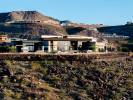OUTDOOR BRIEF
FIVE QUESTIONS
Things to know before taking a child fishing
When it comes to taking kids out for a day or more of fishing fun, it’s a common occurrence for them to ask lots of questions. They aren’t afraid to make adults aware that they don’t know everything but are willing to learn. However, children aren’t the only ones who have questions about fishing. Aquatic Education Coordinator Ivy Santee said there are five questions that are most asked of the folks at the Nevada Department of Wildlife.
• First, “Do I need a Nevada fishing license to take my child fishing?”
Whether you need a license or not will depend on how much assistance your child will require. Can the child bait his own hook or cast her own rod? And who reels the fish in and removes it from the line? The answer to these questions will help determine who is really doing the fishing. If you are only supervising the child, and they are capable of doing everything else, then you are not required to have a Nevada Fishing license. But as soon as you start baiting the hook, casting the rod or reeling in the fish and removing it from the hook, then you need a valid Nevada fishing license.
“Just ask yourself this question: ‘If a game warden were to watch me do what I am doing, would the officer think that I am fishing?’ If the answer is yes, then save yourself a headache and get a license,” said Karen Welden, a game warden with the Nevada Department of Wildlife.
• Second, “Does my child need a Nevada fishing license?”
Generally, a Nevada fishing license is required for all anglers 12 years of age and older who are fishing Nevada’s waterways. The only exception is when one is fishing certain interstate waters. On Lake Mead, Lake Mohave or the Colorado River where Nevada meets Arizona, a license is required for those who 14 years of age and older. When fishing Lake Tahoe and Topaz Reservoir, a license is required for anglers who are 16 years or older.
• Third, “Where is the best place to take my child fishing?”
Local ponds are usually the best places to start children fishing. They are close to home, have amenities such as restrooms and water fountains, and also have the largest populations of fish in proportion to the size of the water.
The three-acre pond at Boulder City’s Veterans Memorial Park has a gradual grade into the water that makes it very easy for children to land fish and is surrounded by small trees for shade. Sunset Park pond is located just south of the McCarran airport at Sunset Road and Eastern Avenue.
Lorenzi Park pond is one of the oldest in town and historically is called Twin Lakes. The two original ponds have been joined into a single two-acre acre pond. With four ponds, Floyd Lamb Park at Tule Springs provides the largest fishing area with large mature trees and temperatures that are often 10 degrees cooler than in town. There is also an entrance fee at this park.
• Fourth, “What kinds of fish can we catch?”
NDOW stocks each of these ponds on a regular basis, but they also have naturally reproducing populations of bass and sunfish. The agency plants rainbow trout during the winter months and channel catfish in the summer. Anglers often catch bluegill, green sunfish, and redeared sunfish. These small fish are a great choice when starting children out fishing.
• Fifth, “What is the best bait to use?”
When fishing with children it’s best to keep it simple and nothing is simpler than worms. Just about any fish will take a worm. During the colder months and when fishing for trout, PowerBait is a great choice for kids. Its doughy consistency makes it easy for kids to handle, but also try Power-eggs. They are similar to small rubber balls that can be reused.
SIGN UP NOW
Avoid the fall rush for hunter education
The calendar still reads July, but the fall bird hunting seasons are only a month away. Those hunters who applied for a big game tag should already have their hunter education card, but there may be some bird hunters who have yet to take the class. For hunters who fall into this category, as well as those who are simply new to hunting, the Nevada Department of Wildlife is currently offering Hunter Education courses.
“We offer classes year-round, but some people miss out by waiting too late to sign up. If they wait too late too often, they miss out altogether,” said Martin Olson, hunter education coordinator for NDOW. “Without their hunter education card, people born after January 1, 1960, can’t buy a hunting license. And anybody who is 12 years old or older has to have a license before they hunt any game birds or game animals.”
A list of scheduled classes and related information is available online at www.ndow.org. Students must pre-register for the class and then obtain and complete a Hunter Education workbook before showing up for class. If the book is not completed, the student will not be permitted to enter the class. The cost is $5 at the door.
In the Las Vegas area, students can register by calling Martin Olson, 486-5127, Ext. 3501.
Artists’ submissions sought for 2008 Nevada Duck Stamp
Artists across the country have been invited to participate in Nevada’s 2008 Duck Stamp Contest. The contest, sponsored by the Nevada Waterfowl Association, is open to all artists with an interest in waterfowl regardless of their place of residence. A full-color rendition of the winning entry will appear on the 2008-09 Nevada Duck Stamp.
Submissions may be completed in any medium, including acrylic, oil, watercolor, scratchboard, pen and ink, and others. However, photographs will not be accepted. Participants are limited to a single entry that is their own creation and may not be copied or duplicated from previously published artwork. The Nevada Division of Wildlife must receive entries no later than Friday, October 15, 2007.
The designated subject for contest is the pintail, one of the most widely distributed waterfowl species in the world and among the first to migrate south each fall. Despite Nevada’s arid climate, some of the pintail’s migration routes cross through the Silver State. These long, slender birds are named for their elongated central tail feathers and can be seen in abundant numbers during the late fall.
A seven-member panel comprised of two representatives from the Nevada Board of Wildlife Commissioners, and five others appointed by the Nevada Waterfowl Association, will judge the contest entries. Results will be announced in mid-November during the association’s fundraising event in Fallon. A list of the top-ten finalists will be available from NDOW beginning at 8 a.m. on November 12.
Contest rules and entry forms are available at art supply stores, at www.ndow.org under “Wildlife and Habitat,” and from the Department of Wildlife headquarters office, 1100 Valley Road, Reno, NV 89512.
New wildfires worsen wildlife habitat problems
Last year, the Nevada Department of Wildlife’s Game Bureau Chief Russ Mason was quoted as saying “These [2006 wildland] fires are an environmental disaster for the state of Nevada. That is not an overstatement. We are losing habitat year after year, with no end in sight.” Unfortunately, fires in 2007 have thus far proven Mason correct.
Year-to-date wildland fires have consumed approximately 341,000 acres in Nevada, according to the National Interagency Fire Center in Boise, Idaho. Tens of thousands of acres are burning every day. In Elko County alone, 300,000 acres have burned. Since 1999 over six million acres of sagebrush habitat has been lost to 8,233 wildfires in Nevada. The future of the charred habitat and its wildlife inhabitants is bleak.
Decreased intervals between fires, invasive weeds, and the uncertainty of rehabilitation efforts will affect wildlife and those recreating in Nevada for decades. Areas of critically important mule deer transition and winter range and important sage grouse nesting and brood rearing habitat have been lost. In addition, chukar and pronghorn have been affected.
Fire Intervals
“Historically, fire intervals are between 100 and 150 years in these areas, and for some sagebrush environments in lower elevations, 200 to 300 years,” explained Shawn Espinosa, Wildlife Biologist for the Nevada Department of Wildlife (NDOW). Biodiversity is affected when these natural cycles are disrupted. “We are now seeing fire return intervals on the order of 10 to 20 years – so the cheatgrass fire cycle is perpetuating itself,” he said. “More frequent
fires preclude sagebrush seedlings that would come back after a fire from ever establishing,” explained Espinosa.
Invasive Species
One of the factors affecting fire intervals is invasive species. In particular, non-native cheatgrass seems to have evolved to obliterate Nevada’s native vegetation. Cheatgrass is so named because it matures early and cheats native grasses, which emerge later, out of essential water and nutrients before the heat of summer sets in. It matures early and dries out early, creating fuel for fires. And it carries fire across areas between shrubs that would normally be bare.
Rehabilitation
“The potential for successful restoration is limited,” said Espinosa. Governmental agencies need to have luck on their side in the form of good precipitation, and the seeding must occur during the first year after a fire in order to out-compete cheat grass. Even then, the odds for sagebrush re-growth are low.” he said. “We’ve seen sagebrush seed response in certain aspects – such as north facing slopes out of direct, all-day sunlight – and at certain elevations conducive for it to grow,” he continued. “Those are the sites we’re concentrating on. South facing slopes will predominantly convert to a cheatgrass environment,” Espinosa said. He noted that even when sage brush areas are reseeded, the overall germination rate is only about 20%.
Wildlife Affected
With the basic fabric of the habitat changing, this doesn’t bode well for a lot of Nevada’s wildlife species. Sage grouse, a native species whose numbers are threatened, have lost numerous strutting grounds, used for mating. “Over the past few years their nesting and critical brood-rearing habitat has been lost as well,” said Espinosa. “We’ve effectively lost these habitats for the next 30-50 years – conservatively,” he said.
The loss of critical deer winter range is being assessed, and the outlook is poor there as well. Areas burned were host to a number of species which will all suffer from the loss of habitat, including sage-dependent species like sage thrasher, vesper sparrow, and pygmy rabbit, as well as Lahontan cutthroat trout and a whole host of upland game species.
After last summer’s fires in Elko, NDOW put satellite tracking collars on 10 mule deer to track their movements. The information will help wildlife biologists learn how burned areas affect the deer’s journeys from summer to winter ranges. The data will also provide information to guide rehabilitation efforts to increase survival rates.
2007 Fire Update
The following describes significant wildland fires to-date. Each of these fires affects habitat for Nevada wildlife species.
Tungsten Fire in the Eugene Mountains: 61,000 acres lost, mostly in lower elevations, affecting mule deer, sage grouse and chukar.
Adrian Valley Fire, Pine Nut Mountains: about 18,000 acres affected at time of this report. Four small capacity water developments (guzzlers) have been lost, likely some sage grouse habitat in upper elevations has been lost, an estimated 40-50 pronghorn likely to be displaced.
Highway 93 complex fire, east and southeast of Jackpot: about 50,000 acres. Burn area is affecting area previously burned in 2000, which already impacted 50 sage grouse breeding grounds (leks). Currently the fire has burned through the largest sage grouse strutting ground in the Gollagher Population Management Unit (PMU) and has also impacted intact sagebrush habitats along the west face of Gollagher Mountain. Year- round sage grouse, mule deer, antelope and elk habitats were lost in the current fire.
Thomas Fire- Sonoma Range: this fire has re-burned several major drainages on the western slopes of the Sonoma Range, with 22,000 acres lost at the time of this report. Riparian areas were destroyed and fish kills have been observed in the Water and Thomas Creek areas. Pronghorn, mule deer, and chukar have been displaced by this fire.
Barth Fire, west of Carlin: burned 11,000 acres of critically important deer winter range.
Bob’s Flat #3, west of Carlin: Burned 8,000 acres and is still burning. This area has burned multiple times since 1999. It is critical winter deer range, and part of NDOW’s rehabilitation areas have been burned.
Hunter Fire, located between the Hunter Banks Ranch and the Carlin tunnels: burned 2,000 acres, impacting intact sagebrush habitats on the south end of the Adobe Range. This is critical winter range for mule deer and antelope, with some sage grouse use.
Rowland Fire in Idaho: flames are pushing south into the Jarbidge foothills. There is a dozer line around the town of Jarbidge, where a voluntary evacuation is in effect.
Hepworth Complex northwest of Wells: This fire complex is estimated at 42,000 acres and is 60% contained. This is a significant sage grouse lek and brooding area.
Winceup Complex northeast of Wells: Burned 16,617 acres and is estimated at 40% contained. This area has been productive for many species, including sage grouse, antelope, deer and elk.
Boo Hoo Complex southwest of Carlin: Burned 15,000 acres and is 10% contained.
Red House Complex west of Elko: Burned 30,000 acres and is 5% contained. This area is Important sage grouse habitat and deer winter range.
Sansinena Fire west of Carlin: Burned approximately 10,000 acres. Important sage brush habitat has been consumed in this critical deer habitat.
Red House Complex west of Elko: Estimated at 30,000 acres and 5% contained. This land is important in supporting sage grouse and deer.


















